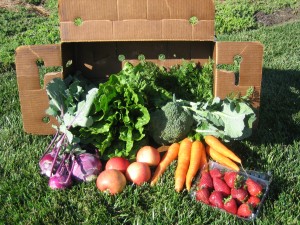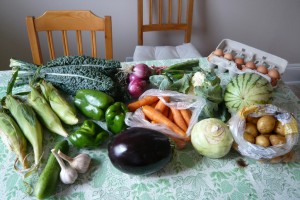Farmer’s markets are one of the oldest forms of direct marketing by small farmers. Farmer’s markets are also a favorite weekly ritual for many shoppers. One popular alternative to farmer’s markets is Community Supported Agriculture (CSA). What is a CSA? The basic definition of a CSA is a food production and distribution system that directly connects farmers and consumers. A farmer offers a certain number of “shares” of their goods to the public. A typical “share” may include vegetables, fruits, or other farm products such as eggs, honey, meat, cheeses, or flowers. Interested individuals or families purchase a “share” or a subscription and in return receive a box of the goods on a weekly basis throughout the farming season.
Most shares or subscriptions are required to be purchased up front and typically many farms will offer half or whole shares. The share size you purchase will depend on your family’s usage and needs. In Ohio, many CSA’s will start distributing their shares to consumers in May and will go through Aug. or Sept. Shares are picked up on a specific day and time frame at the farm or at designated drop off points throughout the week. Some CSA’s may offer delivery for an additional fee.
Advantages for farmers:
- Get to spend time marketing the food early in the year, before their 16 hour days in the field begin
- Receive payment early in the season, which helps with the farm’s cash flow
- Have an opportunity to get to know the people who eat the food they grow and their wants and needs
Advantages for consumers:
- Eat fresh, local food, with all the flavor and vitamin benefits
- Get exposed to new vegetables and new ways of cooking
- Usually get to visit the farm at least once a season
- Find that kids typically favor food from “their” farm – even veggies they’ve never been known to eat
- Develop a relationship with the farmer who grows their food and learn more about how food is grown
Points to consider:
- Depending on the weather and growing season, some produce may be provided in abundance and some may not. You generally do not have choices like you would at the grocery store.
- When you purchase a share you are also taking a “shared risk” of weather or pests that growing season with the farmer.
- Many CSA’s require their members to purchase the share up front with a one-time fee. This initial investment may seem pricey, however, remember the cost should be divided by the number of weeks of the growing season and include consideration of all the advantages above. Some CSA’s may offer payment arrangements. Typically the share must be paid for in full prior to the start of the weekly distribution.
- There are variations across CSA’s. They may offer shortened growing season shares. Some CSA’s only offer vegetable shares. Others may offer both fruit and vegetable shares and possibly additional items.
- Will you be able to pick up your weekly share during the designated time frame?
- Some farms may offer “sweat equity” and allow you to work for a few hours on the farm in exchange for a reduced rate share.
If you are interested in a CSA, ask your friends or family for recommendations. You may also ask the farmer for references from previous CSA members before you sign up. Most CSA’s are offering shares right now. To start taking advantage of the upcoming harvest visit www.localharvest.org to find a CSA near you. I am excited to be picking up my first farm share the week of May 19th. Support local farms and enjoy local food!
Written by:
Melissa Welker
Family and Consumer Sciences Extension Educator
Ohio State University Extension
Fulton County, Maumee Valley EERA
welker.87@osu.edu
Reviewed by:
Bridgette Kidd, MPH, RD
Program Specialist, Healthy People
Ohio State University Extension
Sources:
www.localharvest.org
www.nal.usda.gov




